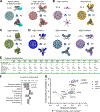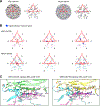Vaccine elicitation and structural basis for antibody protection against alphaviruses
- PMID: 37295404
- PMCID: PMC10411218
- DOI: 10.1016/j.cell.2023.05.019
Vaccine elicitation and structural basis for antibody protection against alphaviruses
Abstract
Alphaviruses are RNA viruses that represent emerging public health threats. To identify protective antibodies, we immunized macaques with a mixture of western, eastern, and Venezuelan equine encephalitis virus-like particles (VLPs), a regimen that protects against aerosol challenge with all three viruses. Single- and triple-virus-specific antibodies were isolated, and we identified 21 unique binding groups. Cryo-EM structures revealed that broad VLP binding inversely correlated with sequence and conformational variability. One triple-specific antibody, SKT05, bound proximal to the fusion peptide and neutralized all three Env-pseudotyped encephalitic alphaviruses by using different symmetry elements for recognition across VLPs. Neutralization in other assays (e.g., chimeric Sindbis virus) yielded variable results. SKT05 bound backbone atoms of sequence-diverse residues, enabling broad recognition despite sequence variability; accordingly, SKT05 protected mice against Venezuelan equine encephalitis virus, chikungunya virus, and Ross River virus challenges. Thus, a single vaccine-elicited antibody can protect in vivo against a broad range of alphaviruses.
Keywords: alphavirus; broadly neutralizing antibody; cryo-EM; in vivo challenge; vaccine.
Published by Elsevier Inc.
Conflict of interest statement
Declaration of interests NIH has submitted a provisional patent application for select antibodies described in this manuscript on which M.S.S., S.K., R.V., P.D.K., and M.R. are co-inventors.
Figures







Comment in
-
Antibody offers broad alphavirus protection.Nat Rev Drug Discov. 2023 Aug;22(8):623. doi: 10.1038/d41573-023-00108-7. Nat Rev Drug Discov. 2023. PMID: 37400711 No abstract available.
References
Publication types
MeSH terms
Substances
Grants and funding
LinkOut - more resources
Full Text Sources
Other Literature Sources
Molecular Biology Databases

